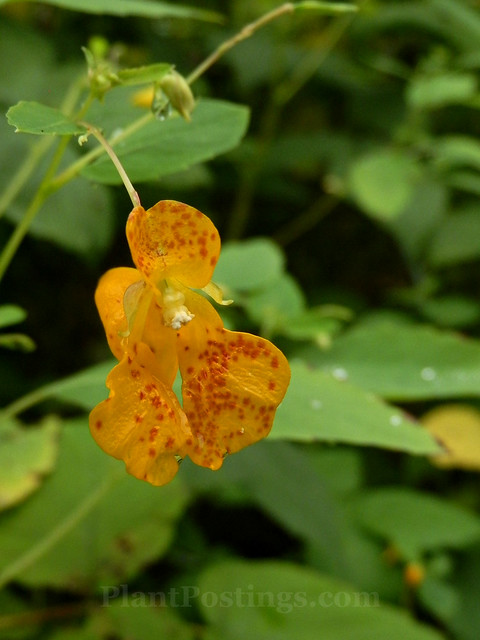
It's Wildflower Wednesday--the fourth Wednesday of the month--when gardeners around the world share information about some of their favorite wildflowers.
This month, my pick is Spotted Jewelweed (Impatiens capensis), also nicknamed Spotted Touch-Me-Not.
It's a tall (four feet), watery plant with delicate, one-inch flowers dressed in orange with red spots. Jewelweed is native to most of the Canadian provinces and the United States, except in the Southwest and some of the mountain states.
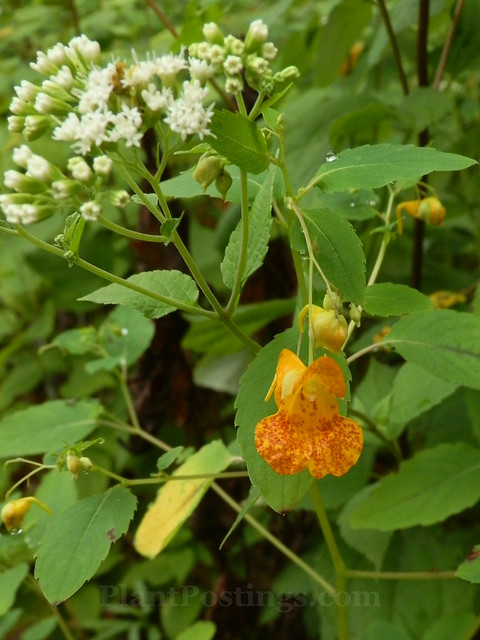
It's naturalized in several areas up at our cottage, including a section facing north near the road, alongside Snakeroot (Ageratina altissima).
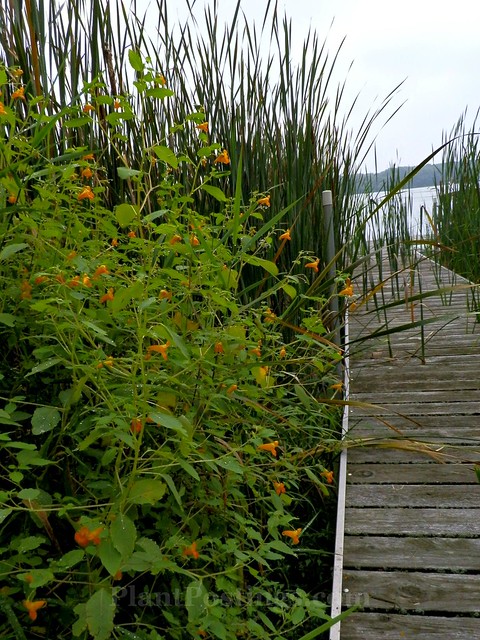
And an area facing south but blocked by tall Cattails (Typha spp.). In the past, the fishman knocked the plants back by the shore, but this year we decided to let them have their way (obviously, we need to trim the Cattails growing through the dock boards).
My last post was about a plant that prefers dry, sunny conditions, while this one prefers wet, shady conditions. But honestly, they've both naturalized in sandy soil and dappled sun, so the only real difference is the moisture level.
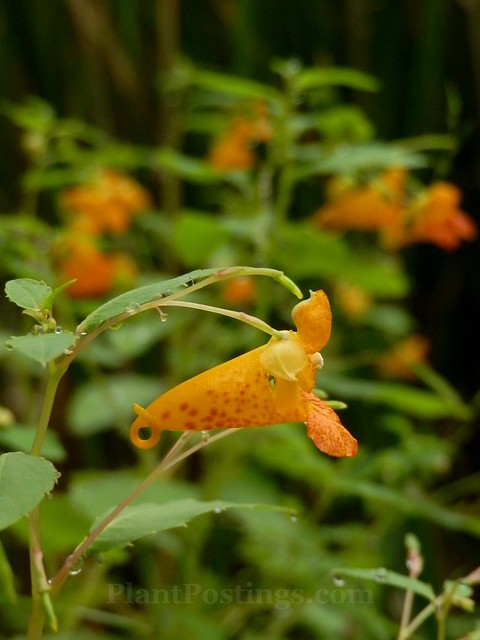
The flower of Spotted Jewelweed has a trumpet shape, with a curly tail at the base. A sack within the flower contains a fungicide that is said to soothe Poison Ivy (I've never had it after numerous encounters, so I've never tried this).
This wildflower, though native to our area, can be aggressive under the right conditions, so we'll keep it in check. This link includes some fun stories about Jewelweeds at The Eloise Butler Wildflower Garden in Minneapolis.
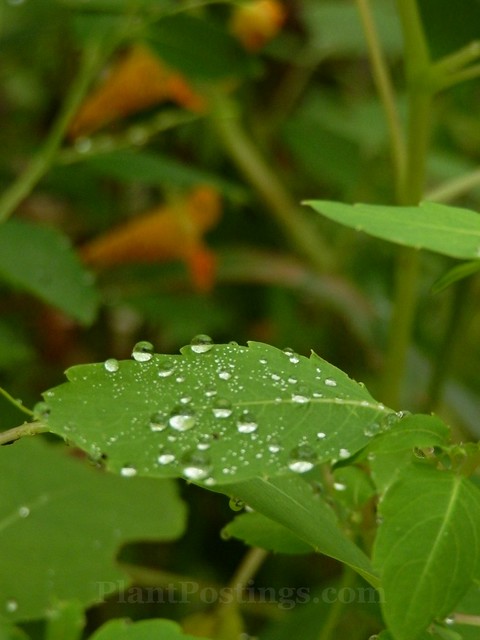
Here you see the reason for the name Jewelweed.
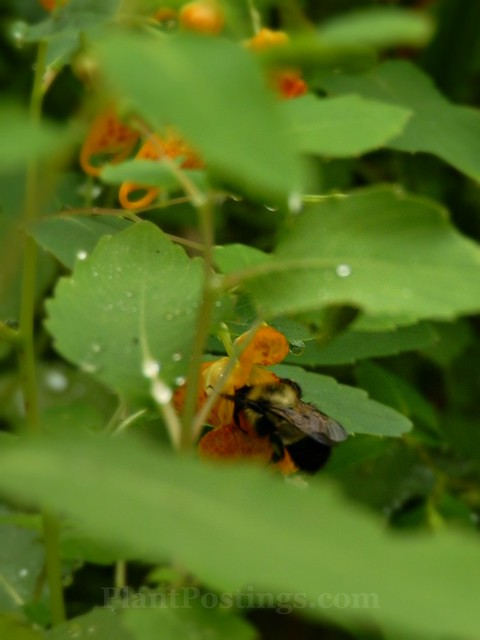
While I was watching, several bumbles crawled deeply into the flowers for pollen and nectar. They fit perfectly in the trumpet. Apparently, Hummingbirds often visit Spotted Jewelweed, too, and they prefer it over the Yellow Jewelweed (Impatiens pallida). I didn't see any hummingbirds on the Jewelweed during our last visit, but I can see why they would like it.
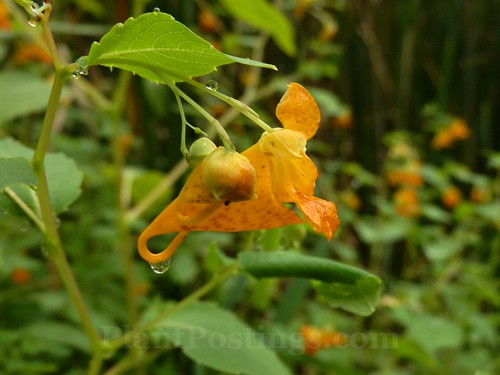
This photo shows the various stages of the flower and seeds--from small pale buds to bright orange flowers to developing seedpods.
The behavior of the seedpods is the source of the plants' other nickname: Touch-Me-Not. If you brush against them or touch them, when fully ripe, they explode--spewing their seeds an impressive distance (several feet).
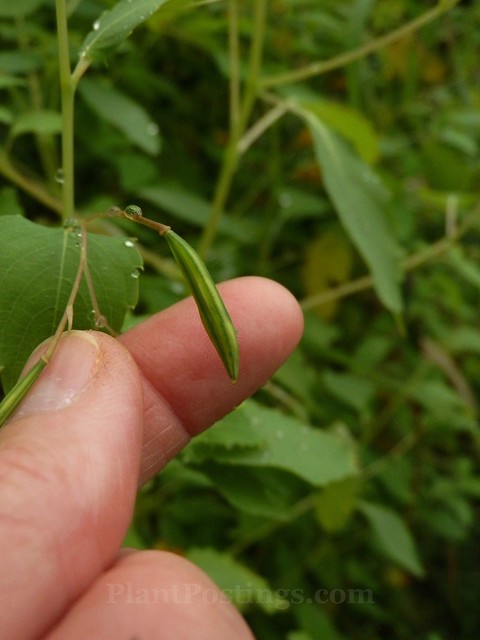
This seedpod isn't ripe, but pinching it will show how the pod curls back, releasing the seeds.
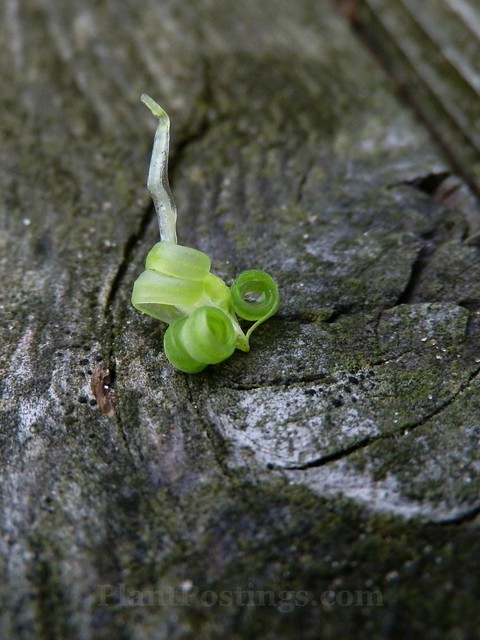
Here's the curled seedpod after the experiment.
I tried to load a video showing this explosive action, so we shall see if it works:
There you have it: Spotted Touch-Me-Not, aka Spotted Jewelweed. I'm linking in with Gail's Wildflower Wednesday over at Clay and Limestone. Head on over to her blog to learn about wildflowers from around the world.
Next up: my "Garden Lessons Learned" for the summer of 2014. What have you learned this season (summer, for those in the Northern Hemisphere; winter for those in the Southern Hemisphere)? I hope you'll join in!
Hi Beth and thank you! This plant was unknown to me. I like its face with freckles! You took a great picture with 'jewels' and your video works! I also like the third pic with grass growing between the planks.
ReplyDeleteTee hee--it does look like freckles, doesn't it? I'm glad the video worked. I've been having better luck with videos lately using a different camera. This seemed like a good post to actually show how the seeds pop. It's a fun exercise. ;-)
DeleteI've heard so much about the amazing healing aspects of jewelweed with respect to poison ivy and even bug bites. I'd love to try it sometime, though I don't really want to get poison ivy to try it! I haven't spotted any blooming in my neck of the woods yet, though there was some near my in-law's house. I bet this one would like all my woodlands, though! It would be great if this would grow instead of all the poison ivy that keeps coming up!
ReplyDeleteI should try it on bug bites--the mosquitoes have been horrible here this summer! Yes, it does seem like a plant that would like your woodlands, during a summer with plenty of precipitation. I don't think it would do well here at my home, because it's so dry here in the middle of summer. If it didn't grow so tall, I could see planting some in pots for the hummingbirds. I could keep the pots watered enough. But four feet tall--hmmmm, I will have to think about that. ;-)
DeleteIt's very beautiful...I don't think I have ever seen it before...wish we had some around here, that color is gorgeous.
ReplyDeleteJen
I do enjoy the color, too, especially massed and naturalized this time of year. I hope the hummingbirds are liking it before they head south for the winter. We've never let it grow in such abundance before, but I'm glad we did this year.
DeleteI love jewelweed and have orange and yellow varieties but no spotted. Theh word invasive does not technically apply to a native plant. Invasives are defined as nonnative plants spreading aggressively to cause harm. Jewelweed just spreads a lot when it's happy, making it not suitable for all spots.
ReplyDeleteThanks for that correction, Carolyn! This is the first year we've let it fill out, but I'm glad we did because the pollinators love it and it seems well-suited to the areas where it's growing. It's nice to have something happily blooming this time of year, when so many plants are fading.
DeleteI've seen quite a bit of orange jewelweed (as my Prairie Plants book calls it) on the bike trails circling Dunn's Marsh. It's a nice, cheery splash of color against the dull reeds and undergrowth. And I hate to contradict Carolyn, but naturalists at the Arboretum do use the word "invassive" with natural species. Many native invassives will take over if not kept in check.
ReplyDeleteI guess it partially depends on where the plant is located and if it's taking over habitat from other plants. I can see how Jewelweed could definitely be invasive in a location it likes where it isn't native. It's very prolific. But it's definitely cheery. And manageable in some places. "Aggressive" is a very good word for it. :)
DeleteThis is a new plant for me and it's a real beauty. I love that you did the experiment with showing how the plant releases seeds with its curled interior. Fascinating stuff. How I love the natural world. I'm biting my tongue with the spelling (above) of invasive...two cents from the editor-:)
ReplyDeleteYes, it's a pretty bloom--and very cheery en masse. It was fun to try to hold the camera while popping the seedpod. :) I'm glad it worked. Yes, it's fun to do these experiments.
DeleteWe have a similar Impatient like that. We call it 'Pacar hutan' or 'Pacar kuning' that's a wild and rare plant that grow in tropical rain forest. Thank you for sharing.
ReplyDeleteI looked it up, and it resembles what we call Balsam plants here. One of my friends grows them as annuals in her garden and the seedpods pop like the Jewelweed pods. Fun with plants!
DeleteWhat a beautiful plant, I' ve never seen it before. The name is lovely too. The seeds and seed dispersal are the same as in our invasive non native Impatiens glandulifera. It is interesting how a plant can be plentiful, but kept in balance, in its native environment, but when introduced somewhere else it can become a danger to native flora.
ReplyDeleteA lovely post, Beth and gorgeous photos.
So true, Chloris! There are so many incredibly lovely plants that are invasive and non-native here, so I'd love to see them in their native habitats. Thanks for your kind comments!
DeleteOh, I've never seen this before! NEVER! It almost looks like a day lily? I'm not far from where you are, and you'd think I'd know this plant!
ReplyDeleteMy beautiful inpatiens have caught a virus and died way too early in the season. The New Guinea variety however, are doing well, but now that I've gone back to the classroom to teach, I have no time to garden!
Thank you so much for coming over to see my post. Oh, the joys of art - we discover so much! Happy day! Anita
I guess there's a certain resemblance to Daylily flowers, or orchids, but the flowers are much smaller than Daylilies. The foliage is very different. Yes, I'm sure you have these plants in your area (The Eloise Butler Wildflower Garden). Sorry to hear about your Impatiens! That happened to me a couple of years ago, so I didn't plant any last year. I missed them! Have a great year in the classroom, Anita!
DeleteI like your experiment. I never did that seeing them at the parks. They grow all over here, so I will have to try it.
ReplyDeleteHave fun! It's one of those things that's kind of like popping bubble wrap--it's addictive. :)
DeleteI've heard of jewelweed before, but have never seen such great photos of it. I love how bumblebees manage to fit into the tightest little places:) I couldn't see the video--still trying to figure out all the oddities in my new computer--but I'll try again later, because I'd love to see how they explode.
ReplyDeleteThank you, Rose! I could watch the bumblebees for hours--they're so entertaining...along with the songbirds, hummingbirds, butterflies, etc., etc. :) The vide is just a little thing showing how the seed pods pop. It's very fast.
DeleteThinking over my lessons today....this is a fabulous flower and I must find it for my garden especially the wet areas.
ReplyDeleteOh, I'm sure you could find a great spot for it in your garden, Donna. Be careful, though, because it can be aggressive. It's a very cheery plant this time of year, but just green succulent-like stems and foliage through most of the summer.
DeleteThat jewelweed is so, so beautiful! And your photos are wonderful--such a treat to learn about new (for me!) plants.
ReplyDeleteThank you! Yes, I so enjoy learning about new plants, too! The more I learn the more I realize how little I know in the grand scheme of things!
DeleteCalifornia poppies do a similar exploding act when the seed pods ripen. It's quite entertaining if there's a paper bag full of them (better be sure the top is not left open). I'm drooling over your cottage...well, its setting, really. What a wonderful escape.
ReplyDeleteGood point about the open bag! I was thinking it would be fun to collect Jewelweed seeds by holding a bag over the exploding seed pods--but I imagine many of them would pop out. The location of the cottage is wonderful. The house on it is simply a double-wide, but the land, the water, the fish, and the plants are fascinating. :) I don't do much "gardening" up there--mostly foraging, observing, and hunting for plants.
DeleteThis is a plant I don't think I've heard of. It's a nice looking bloom!
ReplyDeleteMost of the season it simply looks like a very green, watery plant that looks pretty when water droplots fall on it. But this time of year it really shines. I didn't realize it was such an important nectar source for Hummingbirds. I guess we'll have to let it masse again next summer. I do like it, but didn't realize it's value.
DeleteI've had plant lust for Jewelweed or other tubular Impatiens for quite some time, I haven't succeeded yet in growing some. It probably wants to be wetter than my hot dry summers. I enjoyed yours, though, very lovely.
ReplyDeleteYes, it's too dry here at my home garden, too. But near the lake it seems to do well--especially during a summer with plenty of rainfall. These naturalized--I've only planted a very few things up at the cottage. So it's fun to see what plants naturally grow there.
DeleteA lovely jewel!!
ReplyDeleteYes, this is the time of year it shines, Lula. To be honest, it's kind of nondescript during the spring and most of the summer.
DeleteWhat a beautiful and delicate looking plant. I love the name too!
ReplyDeleteYes, it is very pretty--especially this time of year. Actually, I didn't realize how pretty it would be before we let it fill in. Usually, we knock it back so it doesn't take over. But I'm not sure I'll do that again. It's nice to have such a cheery bloom at the end of the summer. :)
DeleteIt's so nice to learn more about Jewelweed. This is my first visit to your lovely blog. I have visited your town many times, as dear friends run a B&B there. ♡
ReplyDeleteMy latest post is about lessons learned in my garden this summer: http://petalspapersimplethymes.wordpress.com/2014/08/25/meet-the-beetles/
Dawn
Thank you, Dawn! Thanks for visiting and joining in the meme! I hope to get the post up on Monday, and then I will include you in the wrap-up at the equinox. There are some very nice B&Bs in the area. So glad you stopped by virtually. :)
DeleteI learn , I grow, I enjoy . . .
ReplyDeleteThank you!
Me, too, Lynne. Me, too. ;-) Cheers!
DeleteI had never seen jewelweed before but it is a very pretty plant! I do remember that my grandmother always referred to impatiens as "Touch Me Nots', and we kids always had to laugh at that name!
ReplyDeleteIt is a funny name, isn't it? I think I'll gather some seeds later this fall--I'm not sure I can grow the plants in pots because they're so tall, but maybe I'll give it a try. :)
DeleteWow, yet another amazing plant from you that I have never heard of! How fun it looks – and those incredible seed pods! Thanks for all the info :-)
ReplyDeleteThere are just so many fascinating plants, aren't there, Helene! We learn so much from each other. I've been thinking about London lately, because it was almost a year ago (October) that we traveled there and I got to meet you and see your beautiful garden. I hope to do another post about Kew soon! Time got away from me last year, and then it was too late to post about things at Kew that happened in the fall.
Deletecapensis? That's a name I expect on our Western Cape plants.
ReplyDeleteI wonder which cape yours is named for?
Good question! I wasn't sure, so I looked it up. I know Wikipedia isn't always the best source, but I figured it would give us a good idea on this one. Apparently, it was a misnomer. The Latin name was bestowed under the impression that the plant was native to South Africa--at the Cape of Good Hope. Here's the link: http://en.wikipedia.org/wiki/Impatiens_capensis.
DeleteNice photos. We had a big stand of this in the backyard when we lived in Madison. Every once in a while I would start pulling out stalks but there were just too many. Could never decide if I should enjoy or be irritated by the flowers.
ReplyDeleteYeah, I know it can be aggressive--even where it's desired and native. I don't have any here near Madison because my home garden is a little too dry--probably because we're up an incline and a little distance from the lake. But Jewelweed sure does like the conditions by the lake up in Marquette County!
DeleteIt is a jewel, if it is a weed! I love its explosive action. I recently discovered the same action with my dried-on-the-vine speckled lima beans. I touched them, and pop! The seeds shot across the garden. No telling where I will have lima beans coming up next year!
ReplyDeleteFun! I don't like the taste of Lima Beans, but I can see growing them just for the fun of popping the dried ones! ;-)
DeleteWhat a delightful wildflower, and I loved that shot of your dock, great place to spend time.
ReplyDelete